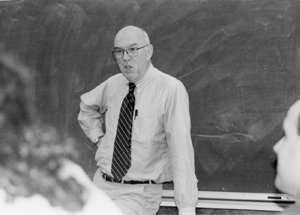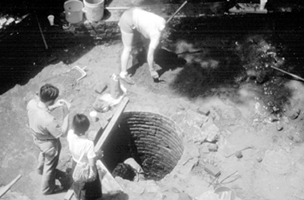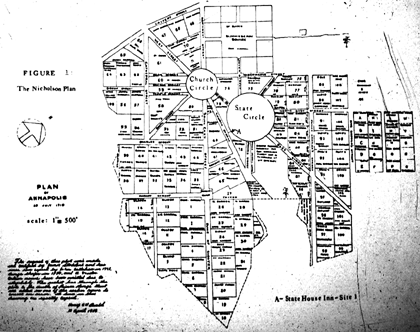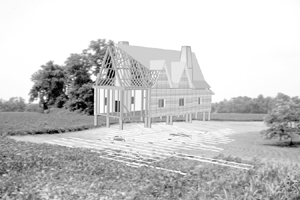 Archeology
Month Interview:
Archeology
Month Interview:Mark Leone Exposing Our Past
No Indiana Jones: Digging up the past takes brains, not brawn
with Don Kehne
 Archeology
Month Interview:
Archeology
Month Interview:
Mark Leone Exposing Our Past
No Indiana Jones: Digging up the
past takes brains, not brawn
with Don Kehne
He's not Indiana Jones: He doesn't wear a leather jacket or dusty fedora; he doesn't carry a revolver; and he doesn't fist fight with Nazis in the Egyptian desert.
No, archeologist Dr. Mark Leone is cut from a different cloth: less rugged, perhaps, but far more substantial. The 59-year-old University of Maryland professor and brain behind the university's archeology "digs" in historic Annapolis is the epitome of an academic. Tall, lanky, bookish and dignified by a refined civility that hints at his New England roots, he's every bit the astute, logical, exacting professor.
Granted, his isn't exactly a household name. Nor would you likely find one of his books, which include The Roots of Modern Mormonism and the forthcoming Historical Archaeologies of Capitalism, on many coffee tables in Maryland. But in the field of archeology he's, well, a Steven Spielberg.
His unprecedented 1996 discovery of spirit charms or 'divining bundles' of colonial slaves in historic Annapolis homes made international news. Nationally, both the New York Times and Washington Post interviewed him extensively about the excavations here.
"He's a pioneer," said Ann Fligsten, director of the Historic Annapolis Foundation, which has worked with Leone and the University of Maryland Anthropology Department for 16 years in discovering not only the history of Annapolis but also its missing African American chapters.
As director of the University of Maryland Field School in Urban Historical Archeology, Leone draws students from around the state, country and the world each summer to Annapolis. This year's site is the Upton Scott House on Shipwright Street.
"Ever since Mark Leone was a graduate student, he's come up with new and interesting ways of doing archeology. He's constantly challenged how archeology is done and how archeologists can work with the public and create history that serves the public interest," notes Jessica Neuwirth, archeologist at Historic Annapolis Foundation.
Peek into one of his archeology seminars at the College Park campus - where he's taught for the past 20 years and chaired the Anthropology Department for the past seven - and you'll sense what he's all about. There's a refreshing, even exhilarating, dynamic at work.
Everyone in the class listens - really listens. Leone speaks in plain English, choosing simple, precise language to navigate the winding waters of archeological theory. When students speak, Leone measures their words then, like a therapist teasing out a patient's buried thoughts, counters, questions and prods them for more. The result: insight that teaches the teacher as much as the student.
Which is sort of the point.
Leone wants his students to learn not only how to teach others about the past but also how to respect and learn from others who ask questions about the past.
He's as encouraging to those of us who don't know all we should know about our past as he is critical of those who say that the past doesn't matter.
If you saw with his eyes, you'd know that the past is not dead, gone and out of mind, but alive, dwelling here and now with and within all of us - whether we're aware of it or not.
 Meet archeologist Mark Leone.
Meet archeologist Mark Leone.
photo courtesy of Historic Annapolis Foundation Archeology in Annapolis, brings students to town each summer to dig into the past.
Q April is Maryland archeology month. With months dedicated to everything from ice cream to good gardening, our readers wonder why they should care. What should we tell them?
AArcheology Month has two parts. One part is for people who live in Maryland. At this time of year, there's an awful lot of archeology made accessible to folks in Maryland by the professional community so that people can see what comes out of the ground that they can call their own.
For Native Americans, archeology unearths a heritage that they should and want to protect as belonging to them before Maryland was a European political entity.
The other side of Archeology Month is a chance for the archeological community to say what it's discovered to itself and to everybody else. So it's a time for a scientific and scholarly community to celebrate its scientific discoveries - which are made over very long periods of time - to make them coherent, to make them available in ordinary English.
So the good thing about having a month to show and talk and tell, walk around, see and celebrate is that when the month is over, everyone will know things that they didn't know before. So Archeology Month is a time for dialogue, at the end of which everyone will know something about Maryland that neither knew before. They'll be more closely linked, too. Since these are Marylanders talking to Marylanders, everybody will know an awful lot more about the entity we share in common.
A Archeology is a discipline that uses things to understand the aspects of past societies that are significant to people's needs today.
We think that knowledge of the past shapes our behavior. But wishes about the past are living wishes and not necessarily filled with factual information about another time.
So the function of archeology is to take stuff that's systematically recovered from the ground - not random objects from the past - and understand them so that our guesses about the past can be distinguished from our wishes about what we want to have happened. That's what archeology is, and that's why it's an important social function that professionals have to play out in front of ordinary Marylanders who are best thought of as fellow citizens.
Q Could archeology be the closest we can come to a time machine?
AOur best time machine is our understanding of how our minds actually work. Humans not only invented the phrase but invented the need. No other creature is capable of thinking about a time machine, and no other creature needs a time machine.
But archeology isn't a time machine; there is no such thing as a time machine. Archeology is things - which we call material culture, or artifacts - from the past by which we discipline our own thoughts. All our thoughts are living, but some of our thoughts are about other times. And we need to have a vehicle like archeology to make sure that our thoughts about other times are not projections but are what we call scientific discoveries.
Q How do you do archeology?
A Deciding where to dig is the hard part - as well as the easy part. Once you've discovered where you want to dig, you make a plan for what questions you want to address:
You begin an archeological site by laying out a grid of squares five feet on each side, measured from an arbitrarily picked spot called the 'datum point.' You use a surveyor's transit to lay out the grid and to establish the rise and fall of the ground across the site.
Then you dig with shovel or trowel or, rarely, with a bulldozer or backhoe. Because it's very important to know where an artifact comes from, you measure and record its distance and elevation from the datum point, so that what's relayed to paper is a true two-dimensional representation of what's there in the ground in three dimensions, including how the ground was disturbed in the past either by farming or by putting in foundations, wells or garbage pits.
Q So an archeologist can't just go at it?
A The purpose of digging carefully is to establish what we call 'context' or the relationship of these artifacts to each other, because once you take the stuff out of the ground, the actual context - the relationship of the bones or seeds to the soil stains, to the remaining rock and posts, to the broken glass, window panes, dishes, cups and so forth - is lost.
As you excavate each five-foot square, you keep a paper and photographic record, which is called the record of 'stratigraphy' or the layers.
The purpose is to record the stuff that's buried so that we can reconstruct how they were put in the ground naturally.
As artifacts are dug up, they are put in bags labeled by 'provenience': a reference number that tells you exactly where on the site the contents came from by location, layer and depth.
When you reach soil that has nothing cultural in it, which is called 'sterile' soil, you close out that square.
After all squares you want to dig are closed, the bags are then taken to the laboratory to be analyzed. There, all artifacts are washed, labeled by provenience, sorted and identified: nails, window panes, broken bottles, dishes, which are all usually datable by time of manufacture.
Then everything is counted and compared with each other, and depending upon what question you began with, you may now have the answer.
Q What are the big questions archeologists hope to answer?
A Archeologists around the world ask the same questions:
Q What special part of those big questions is yours?
A I do something called historical archeology. Historical archeology examines how Europe expanded so that it took in all the rest of the earth. So historical archeology deals with how colonies - European colonies - were established and grew.
Because Europe's economy was capitalism, historical archeologists want
to know how some people become poorer and stay poor and how some become
rich and stay rich. So we want to know about stratified social structures
that are called classes. Because almost all colonies depended upon slavery,
and because most slaves - but not all - came from Africa, we study the African
Diaspora.  What is left from Africa is
a question we entertain and find answers to. How slaves become free people;
how farming is done by tenants; how power is organized and maintained so
that it's held as a monopoly. Those are the big questions in both prehistoric
archeology and historical archeology.
What is left from Africa is
a question we entertain and find answers to. How slaves become free people;
how farming is done by tenants; how power is organized and maintained so
that it's held as a monopoly. Those are the big questions in both prehistoric
archeology and historical archeology.
courtesy of Historic Annapolis Foundation Annapolis' city plan: Illusions of grandeur.
Q Annapolis is one of your particular interests?
A One of my basic interests, which I realized through the way we do archeology in the capital city of the state, is to take material from the past to answer questions people bring forward. People of Annapolis wanted to know what was below their ground: what was there. They wanted to know how this stuff was connected to themselves. They wanted to know how the landscape of the city worked.
African Americans wanted to know where was their African heritage, how they became free and whether any of the city's past was their own. All people wanted to know that the past of Annapolis was there and that they could not only have access to it but also help protect it.
My first interest in Annapolis revolved around landscapes: How was the city's land shaped. Then, starting in 1990, my interest became what was the city's African-American heritage.
So my interests are four. The first is the relationship of archeology to the public. The second is the landscape of the city of Annapolis. The third is African American heritage. And the fourth is how Annapolis make itself into a community in the course of the 18th century. Not so much how the city was built but how the population was made into a group of urban citizens who felt like they were a community.
Q Of the discoveries you've made, what seems most vivid and important to people?
A The diviners or conjurers bundles that we have discovered underneath the kitchens of the great houses of Annapolis - the Charles Carroll house, the Slayton house and the Brice house - are vivid encounters with the remains of a world we didn't know existed. Neither white people nor black people of the city knew that world existed.
These bundles are analogous to West African nkisi (plural: minkisi). They are buried in the ground, under hearths, in the northeast corners of rooms and under doorsills, locations that we discovered archeologically. They're used to control the spirit world that's believed in by the people whose ancestors are African. It's a world called Hoodoo, a North American version of Voodoo.
The dead produce spirits that wander and can be used for good and evil and these bundles - ritually produced bundles that are buried - control the passage of spirits up and down chimneys, in and out of doors. They can be used to cure, protect and control the future.
There was no knowledge of these prior to our discovering them. We made our discovery initially by accident but in a deliberate hunt for an answer to the question 'What's left from Africa?' which was posed by a prominent member of the African American community of the city.
Certainly it is a vivid encounter with the remains of the past that led us to understand a world that operated in secret. It was kept secret from white people to protect the slaves and their religion. It was also a secret in the sense that these were wordless practices used to control a spirit world that was controlled through actions and not by words.
So the vividness you asked me about is a vivid discovery of a wordless religion.
Q Everybody gets lost in Annapolis. Tell me what you've learned about the city's layout.
A The other remarkable discovery we've made is a discovery whose surface was known for a long time: Annapolis is not a grid. Everybody who knows anything about the city knows that it was designed by Sir Francis Nicholson, the royal governor, as a baroque city. What that means is that the major lines of sight in the city couldn't have been produced by laying down a grid.
The way to understand a baroque plan is to imagine the end of a funnel: depending on the end you look in, a funnel has either expanding sides or constricting sides. Depending upon where you're pointed, the object you view - the State House, the church or if you're in the William Paca Garden, the Great House on the water - is manipulated by the way the lines of sight are constructed.
You can see the streets that radiate out from State Circle and Church Circle as the part of the funnel that controls how the buildings appear. If the lines come together at the focal point, the optical illusion is that the building is farther away than it actually is. If the lines spread out, the object appears to be closer than it actually is. If the ground ascends, the object appears grander and larger than it actually is. And all these play together in a sculpted volume so that the objects holding the people in authority appear to be something other than what they actually are.
We discovered how the volume of Annapolis actually worked. That the sides of the main streets are not parallel. We actually did discover that.
We discovered that State Circle is an egg and not a circle, never was a circle and was never intended to be a circle. But we also discovered that it was intended to appear to be a circle, and the way you make a space appear to be circular is to draw either an ellipse or an egg. So State Circle looks like a circle because it was actually drawn as an egg. That is a pretty vivid discovery.
Q Why would Sir Francis Nicholson want that sort of street plan?
A This is a theory of urban planning that was used in baroque Europe to enhance monarchical authority. It comes out of Renaissance principles of perspective, and it was actually put into place in Rome, Versailles and then in London with Christopher Wren's plan for rebuilding the city [after fire destroyed much of it in 1666].
This theory was understood by many civil administrators like Francis Nicholson when he was put in charge of establishing royal authority in Annapolis after the colony passed to the crown and the capital was moved from St. Mary's to Annapolis. It was a well-known way of aggrandizing central authority at the time when the British crown had weak hold over the colony.
 The purpose of a baroque street plan is to create in
three-dimensional space ways of enhancing objects of authority. In Annapolis
the objects of authority are the state house and the state church: the Anglican
or Episcopal Church. It isn't that those are the objects; it's the people
inside who not only desire authority but request and require it.
The purpose of a baroque street plan is to create in
three-dimensional space ways of enhancing objects of authority. In Annapolis
the objects of authority are the state house and the state church: the Anglican
or Episcopal Church. It isn't that those are the objects; it's the people
inside who not only desire authority but request and require it.
Nicholson later used the same ideas a few years later when he designed Williamsburg.
Remnants of a 'divining bundle' unearthed at Charles Carroll House: Slaves had buried charms and crystals with a broken bowl on top.ole building
Q What can you say about Annapolitans of the past that they didn't know about themselves?
A Nobody understood the principles of baroque plan until we proved that it's done in three dimensions, not in two. What we understand about Annapolis now is that from the beginning it was an invented community.
Most people understand only that it was a planned landscape; that is, its planners laid out the city deliberately. What people don't understand is that all aspects of collected life have been planned since the city was founded. The city is not a plan; it's a constructed space. The gardens, too.
From 1740 for the next 100 years, the Maryland Gazette [further] established community by making type that was used to construct information that was ever more regular and authoritative and by dropping out authorship. We now know that from an analysis of the printer's type.
Behind all this is the world of African Americans and a religion of Hoodoo, which operates in secret not only from white people but from one black to another. So there is a world that was not only invisible and unconscious or unaware, also deliberately kept secret.
So there are many Annapolises inside Annapolis.
Q So archeological discoveries refine, revise, challenge, even supply our notions of the past. Can you ever say "That's it! I've got it!" brush off your hands and close the book? Or must history always be re-written?
A The reason that people in Annapolis protect the past has nothing to do with the past itself: the past doesn't speak. The reason to protect the past is that it's always there. Of course, people's interest in the past change.
Because the remains of the past in Annapolis are so intact - because of the systematic rather than random nature of what's preserved - they can provide new insights as people's interests change.
So, no, we've never got it. And there's no need to ever get it. There is a need to be quite constant in our understanding that people need a way of focusing on their interests in the past. We need to give people a reliable way of telling the difference between fantasies and systematic knowledge derived from digging in the ground.
Q You've worked hard in Annapolis on the public aspect of archeology: high visibility, tours of sites, lots of interaction with the public. Why is that?
A We'd planned public involvement from the beginning. I did not want to do another Williamsburg, where archeology is hidden from view. Here we trained archeology students to be tour guides. We didn't use professional actors who didn't know anything about the history they were presenting.
The reason for having young scientists explain their work to the public had two aspects to it. It made young people fluent in explaining stuff that they were just learning to sympathetic listeners, to whom they also had to speak in common English.
And it gave people a chance to ask often piercing questions and questions whose common sense was never failing and to get those questions respected.
So it was a wonderful double reversal. It was a play on citizenship: young people who were becoming scientists got a chance to practice scientific English to tolerant, interested older adults who could practice their citizenship skills by training younger people to take their questions seriously. Everyone became equal as a result of this dialogue that happened thousands of times in the capital.
The University of Maryland couldn't have gained the public's trust in Annapolis without the help of Historic Annapolis Foundation. Then the Maryland Humanities Council provided money for training the students as guides. That's a Maryland institution that's not adequately appreciated.
Lots of other people caused "Archeology in Annapolis" to happen.
Q Why did you choose archeology for a career?
A I always wanted to be an archeologist. I don't particularly have a deep understanding of that. I just like it.
Q What are the good parts of the job?
A The good part is that it's an impossible job. Archeology is constructed so that it cannot be possible. We in the Western hemisphere assume that you cannot know the past directly and that the evidence is very far removed from reality. So how do you overcome those two assumptions to learn what you want to know, which is what happened in the past? The challenge in archeology is doing something that's virtually impossible to do.
Q And what's the bad side?
A I don't think there are
any. Archeology is universally appreciated. It's great to be there. At this
point in my career, there isn't a down side. I've dug in Annapolis since
1981, and it's become a great success in Annapolis and in Maryland. People
enjoy it. There's no bigger thrill in life than to have your work enjoyed.
Q How does one of the readers you've inspired become an archeologist?
A For the kind of archeology we do, you start by majoring in anthropology in college. Nowadays, there are more and more opportunities to try it out before then: in the Boy Scouts, as a volunteer on a dig or in a museum and at some high schools where it's taught. But basically you have to wait until college. It's easy to get in as a volunteer, but it's hard to become a professional archeologist without a degree.
Q What other archeological wonders in their state should Marylanders be aware of?
A In the past 15 or 20 years, Maryland has become aware of its historical archeological heritage, and it's started to celebrate and protect it. Much more can be done in that area.
What Marylanders are finding out is that our archeological heritage is a great way of tying the state together, a great way of celebrating how communities are made.
The greatest treasure that Maryland has is the sunken heritage in the Chesapeake Bay both prehistoric and historic. But that heritage will be difficult to get to, and will require a lot of intellectual effort and some money
| Issue 15 |
Volume VII Number 15
April 15-21, 1999
New Bay Times
| Homepage |
| Back to Archives |